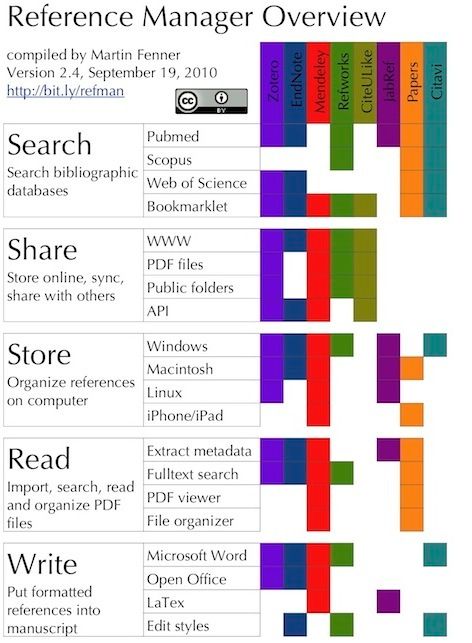Last week Lambert Heller and myself did a two-day workshop Reference Management in Times of Web 2.0 for a group of German librarians. We introduced and tested the following five programs:
The goal of the workshop was to introduce the participants to the Web 2.0 aspects of these reference managers. We briefly talked about Papers and Citavi, but neither of them offers any Web 2.0 functionality. The goal of the workshop was not to pick the best reference manager. With the exception of CiteULike (which is more of a social bookmarking service and can't be used to directly put references into manuscripts), all of them are probably good choices for most users. For some of the minor differences, please check my reference manager chart that I have updated for the workshop (PDF here):

We had used FriendFeed for the slides, links and comments in a similar workshop last July. This time we picked ScienceFeed, both because ScienceFeed can be used for reference management, and to test the service that launched just three days earlier. The ScienceFeed group can be found here, but is in German. FriendFeed and ScienceFeed are not only great for conference microblogging, but are also excellent teaching tools, especially in a workshop where every participant has an internet-connected computer. We also had a few people listening in and putting up comments.
The workshop did help me understand what could become one of the most important features of reference managers. (I would exclude Endnote because it doesn't allow public groups or sharing of full-text files). Libraries used to be places where you could find, store and read literature. A library would hold a subset of all the available literature, but still, far more texts than an individual could keep at his home. A library serves as an intermediary that helps the user get access to the literature he is interested in.
A reference manager that stores all references and the associated full-text PDF files in an accessible (public or password-protected) place can fullfill exactly the same role. It is not necessary that an individual user stores every reference and fulltext paper on his own computer. And he doesn't have to find all references for himself. Librarians could help with this, e.g. by not only handling a users search request but also filing the associated PDF files in a group folder. Other group folders would have the table of contents of your favorite journals (e.g. CiteULike Journals). We used to go to the library for exactly these things. And now we do this all on our own, often not asking for help from our local library.
In the last session I talked about non-traditional ways to find scientific literature. Traditional would mean one of the following search strategies, summarized by Duncan Hull et al.1:
- Search – Search bibliographic databases
- Browse – Scan tables of contents
- Recommend – Recommendations by colleagues
Twitter is just a modern tool for strategies #2 (check the Twitter list @mfenner/science-journals for some science journals using Twitter to announce interesting articles) and #3 (papers recommended by friends you talk to via Twitter).
The non-traditional approach basically lets other people do the work for you. Some examples include:
- Experts pick noteworthy papers in your field – Faculty of 1000 and Research Blogging.
- You follow what people with similar interests are reading – CiteULike and Mendeley
- Recommendations based on what is in your library – CiteULike recommendations
- Most popular articles in your research field of interest – CiteULike and Mendeley. The PLoS article-level metrics have the potential to do the same.
References
- Hull, D., Pettifer, S. R., & Kell, D. B. (2008). Defrosting the Digital Library: Bibliographic Tools for the Next Generation Web. PLoS Computational Biology, 4(10), e1000204. https://doi.org/10.1371/journal.pcbi.1000204


